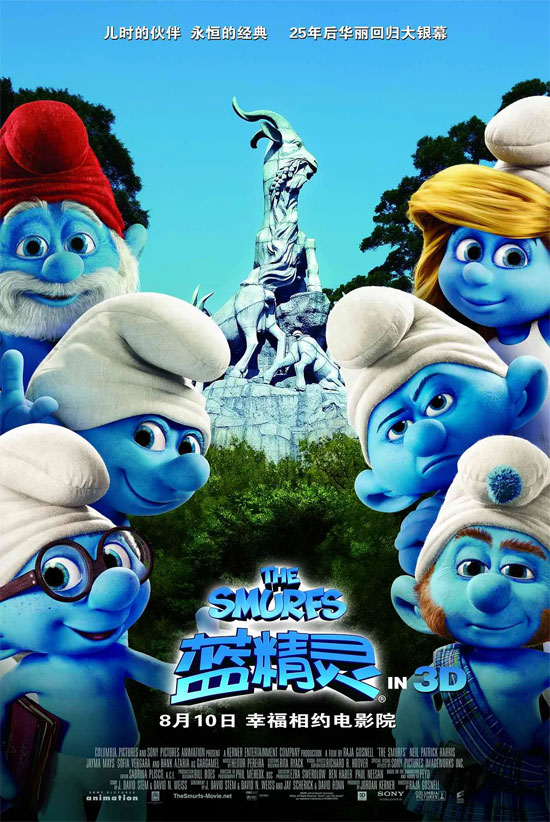Film Name: 蓝精灵 / The Smurfs

The very first episode of the animated series “The Smurfs” depicts the Smurfs living in a forest world far removed from humans. The camera pans from a human castle to a verdant woodland, and humans never appear again. In essence, the core spirit of “The Smurfs” narrative is to avoid human presence, transforming the mushroom forest where the Smurfs dwell into a secluded utopia. Note: Gargamel in “The Smurfs” is a wizard. Wizards are a race opposed to elves; they seek to devour elves. Wizards are not humans in the conventional sense.
The comics and animated series of “The Smurfs” consistently depict events within this isolated realm. Though devoid of humans, the Smurfs themselves function as the ‘humanity’ within this “utopia.” They possess human-like emotions—joy, anger, sorrow, and happiness—along with diverse personalities. They maintain their own society and interpersonal relationships, much like humans. Cartoonist Peyo used the Smurfs’ world as a metaphor to explore human society. This allegorical approach lies at the core of the Smurfs’ closed worldview.
In the Smurfs films, however, these Smurfs—who originally lived self-sufficiently and self-entertainingly in their closed space—are transported into the human world. This premise fundamentally undermines the allegorical nature of the Smurfs narrative. If they lived “beyond the mountains and seas,” why would they need to cross over to this side? It can be argued that from the moment the Smurfs crossed over from the Mushroom Forest, they ceased to be Smurfs and became Smurf pets. In the human world, they exist merely as pets and playthings, no longer the independent “humans” they were within their closed realm.
Once upon a time, we all yearned for the Smurfs’ world—a place where “people” were kind, loving, united, and supportive, a truly warm and welcoming utopia. Yet, unexpectedly, the film plays with the concept of crossing over, not by sending humans to the Mushroom Forest, but by sending the Smurfs into the human world. But that’s not the worst part. These Smurfs seem to have had an epiphany. Upon returning to the Mushroom Forest, they immediately begin mimicking every aspect of human society—from skyscrapers to the Statue of Liberty, from M&Ms to rock music… Is this still the same simple Mushroom Forest? Fellow Smurfs, I’m utterly bewildered. If this continues, the forest will cease to be a forest!
Admittedly, the film’s portrayal of the Smurfs mimicking human society to rebuild their homeland serves merely as a closing gag. Yet while this gag elicits laughter, it leaves a lingering question: Which world is truly the utopia? And which side should yearn for the other?
The Smurfs movie and the Smurfs animated series offer starkly different interpretations of this question. In the live-action film, the Mushroom Forest—supposedly the “utopia”—turns out to be nothing more than a quaint “countryside.” The Smurfs reach the human world, their supposed “utopia,” only once, yet they are “evolved” into denying their own identity, becoming spiritual slaves to American urban ideals and anthropocentrism. Once again, American blockbusters demonstrate how it takes just 100 minutes to redefine a place—from an idyllic utopia to a backward, outdated backwater.
And what impact did the Smurfs—symbols of kindness and innocence—truly have on humanity? Beyond Papa Smurf helping Patrick understand the meaning and responsibility of “fatherhood,” the deeper human-Smurf interactions I anticipated scarcely materialized. For instance—
Patrick’s advertising executive boss Odile is a ruthlessly profit-driven businesswoman. I expected her to aid Gargamel in capturing the Smurfs to obtain his youth-restoring formula, and I imagined she might eventually be moved by the Smurfs’ kindness, prompting her to reflect on her previous money-obsessed, self-serving ways. Unfortunately, the film offers no emotional or ideological evolution for this character. Her ultimate satisfaction remains confined to achieving the advertising goals for Blue Moon. Crucially, she pays no price for her relentless pursuit of profit. This stands in stark contrast to the beautiful values the Smurfs bring from their world. After going to such great lengths to travel to the human world, they return without changing anything—an outcome audiences simply cannot accept.
Please specify:Anime Phone Cases » The Smurfs 2011 Animation Film Review: Which side is the Peach Blossom Spring?